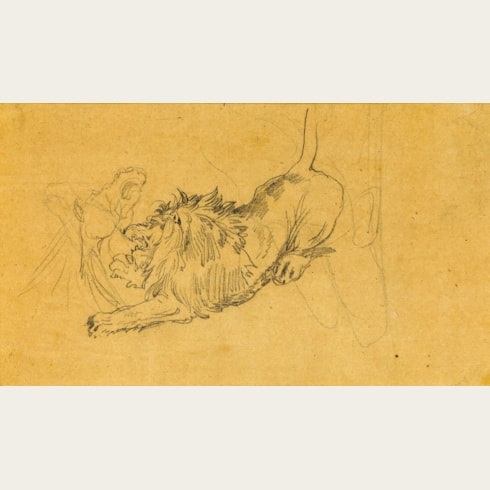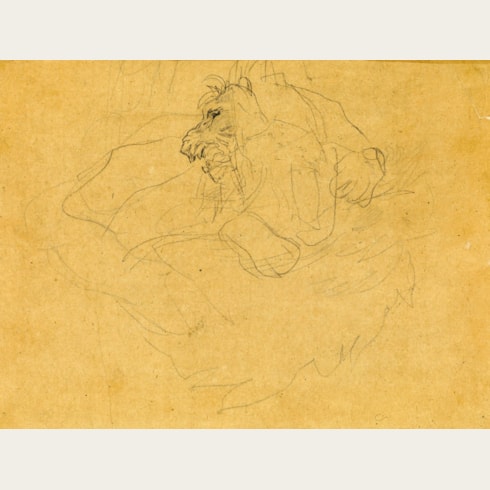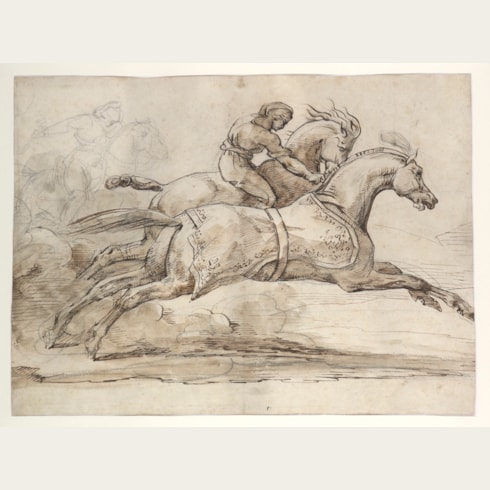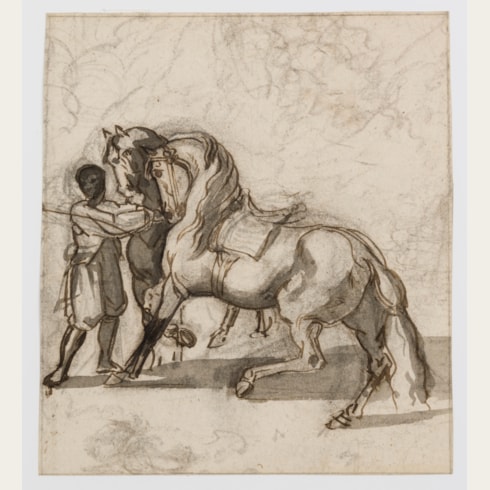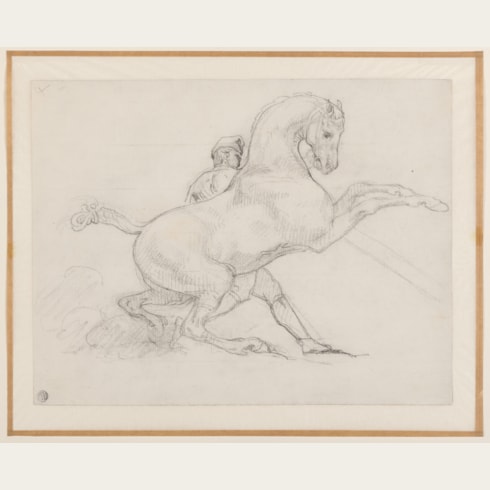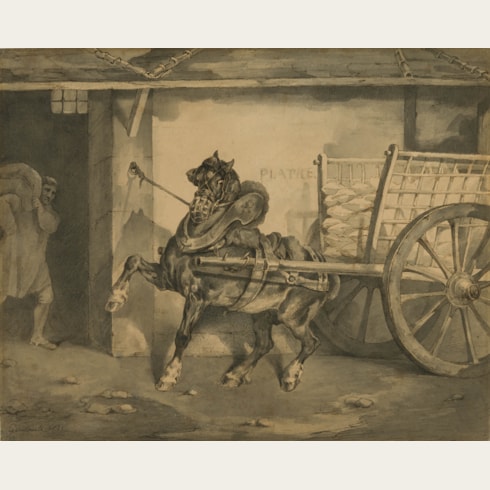Théodore GERICAULT
(Rouen 1791 - Paris 1824)
A Horseman in a Landscape [recto]; The Battle of Landshut, after Louis Hersent [verso]
Inscribed attaque du Pont de Landshut in pencil in the left margin.
Small made-up areas at the upper and lower left corners, and at the upper centre edge.
253 x 316 mm. (10 x 12 1/2 in.) [sheet]
The Salon of 1810 was also the venue of the Decennial Competition, established by Napoleon to exhibit and reward the finest French history paintings of the previous ten years. All of this would have provided a young artist such as Géricault with much to be inspired by. As the scholar Lorenz Eitner has noted, ‘A scattering of drawings, perhaps the remnants of a sketchbook started in about 1810, records Géricault’s early impressions of the modern history painting of the time. A number of them are copied from pictures exhibited at the Salon of 1810: Girodet’s Revolt in Cairo, Hersent’s Attack on Landshut, and Gros’s Battle of the Pyramids (of which he also painted a copy in oil) and Surrender of Madrid. The drawings are dashingly executed in strong pen strokes, washed with bold spots of sepia. Their confident, individual manner gives no hint of Guérin’s influence…In these fairly casual works we catch the first glimpses of a personal manner, still rather uncontrolled but free of doubt or hesitation, and driven by an excess of energy that causes his pen to race across the paper in wild loops and flourishes.’ As the same scholar further notes, ‘The versos of several of these drawings contain sketches of horsemen in the manner of Carle Vernet.’
The Battle of Landshut took place in the Bavarian town of that name, on the banks of the Isar river, on the 21st of April 1809. It was fought between Napoleon’s army of French and German soldiers, numbering around 77,000 troops, against a much smaller Austrian force of some 36,000 men. Although the Austrians fought bravely, they were pushed back to the southern of the two bridges spanning the river. They set fire to the bridge to stop Napoleon’s troops crossing, but rainfall over the previous days meant that they were only partially successful in destroying the structure. Napoleon ordered his aide-de-camp, General Georges Mouton, who was later to become the Comte de Lobau, to cross the still-burning bridge with grenadiers from the 17th Line and attack the Austrians at the far end. Facing heavy fire from the Austrian forces, Mouton ordered his men to storm the far end of the bridge, running at speed without stopping to fire their muskets, and thus overwhelmed the defenders. Praising Mouton’s capture of the bridge at Landshut, Napoleon - making a pun on the general’s surname - is reported to have exclaimed ‘My sheep is a lion!’
As the Géricault scholar Germain Bazin has written of the present sheet, ‘It is understandable that our artist, looking for subjects to inspire him, should have been interested in the Capture of Landshut, an episode set on the 21st of April 1808 [sic] and showing the dazzling action of General Mouton, the Emperor’s aide-de-camp, who, at the head of the grenadiers of the 17th de Ligne (Morand division), rushed under a deluge of gunfire over the great bridge in flames that spanned the main branch of the Isar. The slightly muddy wash of this watercolour painting, which is in fact very clear, could give the impression of a nocturnal episode; the brushwork is heavy, the figures are puppets; on the back is a Horseman Galloping Through a Forest ‘which could be a copy of a composition by Carle Vernet’, according to Clément; the horse is made of iron, the rider of wood, and the latter gallops between theatre flats intended to represent a forest.’
As well as the painting by Hersent, Géricault made similar pen and wash copies of several other history paintings shown at the Salon of 1810, including Anne-Louis Girodet’s The Revolt at Cairo and Baron Gros’s The Surrender of Madrid; both drawings by Géricault, each stylistically similar to the present sheet, are today in the Musée Bonnat-Helleu in Bayonne. While Géricault is likely to have made his freely-drawn copies directly from the paintings exhibited at the Salon of 1810, he could also have based his works on reproductive engravings, as Eitner has suggested.
This watercolour was in the collection of the 19th century French painter, curator, patron and collector Eudoxe Marcille (1814-1890), and has since remained with his descendants until recently. Marcille was a pupil of Eugène Devéria and served as director of the Musée d’Orléans and president of the Société des Amis des Arts in the 1870s. In 1874 he organized an exhibition of the work of Pierre-Paul Prud’hon at the Ecole des Beaux-Arts, to which he lent several works from his own collection, and in 1879 was named a chevalier of the Legion d’honneur. Both his father François-Martial Marcille and younger brother Camille Marcille were likewise noted collectors. The elder Marcille’s collection was partially divided between his two sons shortly before his death in 1856, while Eudoxe Marcille also acquired some works from the posthumous sale of his brother’s collection in 1876.
Provenance
By descent to the Chevrier-Marcille collection, Paris, by 1924
Thence by descent.
Literature
Exhibition









